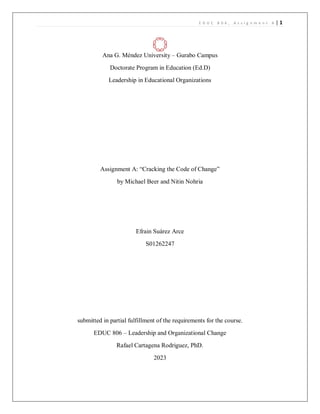The document summarizes key points from the article "Cracking the Code of Change" about two theories of organizational change - Theory E focused on economic value and Theory O focused on building organizational capabilities. It provides an example of how ASDA grocery chain CEO Archie Norman successfully combined both theories in transforming the struggling company. Norman first applied Theory E through restructuring and job cuts. He then shifted to Theory O, making the culture more open and empowering employees. Working with his partner Leighton, they were able to build organizational capabilities that increased shareholder value eightfold and made ASDA attractive for acquisition.



![E D U C 8 0 6 , A s s i g n m e n t A | 4
CASE IN POINT: ASDA
In December 1991, Archie Norman took over as CEO of ASDA, the UK grocery chain
that was nearly bankrupt. In his first speech he said:
“Our number one objective is to secure value for our shareholders and secure the
trading future of the business. I am not coming in with any magical solutions. I intend to spend
the next few weeks listening and forming ideas for our precise direction.... We need a culture
built around common ideas and goals that include listening, learning, and speed of response,
from the stores upwards. [But] there will be management reorganization. My objective is to
establish a clear focus on the stores, shorten lines of communication, and build one team… First,
I am forthright, and I like to argue. Second, I want to discuss issues as colleagues. I am looking
for your advice and your disagreement.”
From day one, Norman set strategy without expecting any participation from below. He
laid off employees, reorganized, and sold off losing businesses - acts that usually cause distrust](https://image.slidesharecdn.com/educ806assignmenta-crackingthecodeofchange-230908132746-c615ba56/85/Cracking-the-Code-of-Change-4-320.jpg)


